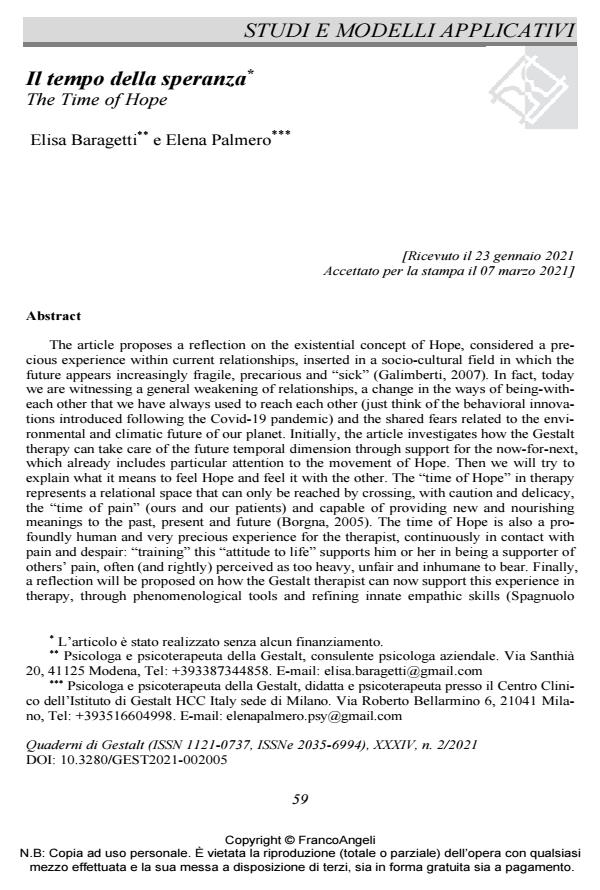The Time of Hope
Journal title QUADERNI DI GESTALT
Author/s Elisa Baragetti, Elena Palmero
Publishing Year 2021 Issue 2021/2
Language Italian Pages 12 P. 59-70 File size 246 KB
DOI 10.3280/GEST2021-002005
DOI is like a bar code for intellectual property: to have more infomation
click here
Below, you can see the article first page
If you want to buy this article in PDF format, you can do it, following the instructions to buy download credits

FrancoAngeli is member of Publishers International Linking Association, Inc (PILA), a not-for-profit association which run the CrossRef service enabling links to and from online scholarly content.
The article proposes a reflection on the existential concept of Hope, considered a precious experience within current relationships, inserted in a socio-cultural field in which the future appears increasingly fragile, precarious and "sick" (Galimberti, 2007). In fact, today we are witnessing a general weakening of relationships, a change in the ways of being-with-each oth-er that we have always used to reach each other (just think of the behavioral innovations intro-duced following the Covid-19 pandemic) and the shared fears related to the environmental and climatic future of our planet. Initially, the article investigates how the Gestalt therapy can take care of the future temporal dimension through support for the now-for-next, which already includes particular attention to the movement of Hope. Then we will try to explain what it means to feel Hope and feel it with the other. The "time of Hope" in therapy represents a rela-tional space that can only be reached by crossing, with caution and delicacy, the "time of pain" (ours and our patients) and capable of providing new and nourishing meanings to the past, present and future (Borgna, 2005). The time of Hope is also a profoundly human and very precious experience for the therapist, continuously in contact with pain and despair: "training" this "attitude to life" supports him or her in being a supporter of others’ pain, often (and right-ly) perceived as too heavy, unfair and inhumane to bear. Finally, a reflection will be proposed on how the Gestalt therapist can now support this experience in therapy, through phenomeno-logical tools and refining innate empathic skills (Spagnuolo Lobb, 2017). In particular, the ar-ticle focuses on the importance of respecting the "right time", necessary in therapy to provide the patient and therapist with the opportunity to feel pain together without running away from it: an essential ingredient to achieve a reworking of all "times of life", through the magnifying glass of Hope.
Keywords: Hope, time, contact-border contact, therapeutic relationship, psychotherapy.
- Borgna E. (2005). L’attesa e la speranza. Milano: Feltrinelli.
- Erikson E. H. (1968). Identity: Youth and Crisis. New York, NY: Norton (trad. it.: Gioventù e crisi d’identità. Roma: Armando, 1992).
- Francesetti G. (2014). Dalla sintomatologia individuale ai campi psicopatologici. Verso una prospettiva di campo sulla sofferenza clinica. Quaderni di Gestalt, XXVII, 2: 31-56. DOI: 10.3280/GEST2014-002003
- Galimberti U. (2007). L’ospite inquietante. Il nichilismo e i giovani. Milano: Feltrinelli.
- Healy T. (2006). Le dinamiche della speranza: aspetti interpersonali. In: Rulla L.M., a cura di, Antropologia della vocazione cristiana 3. Aspetti interpersonali. Bologna: EDB.
- Meissner W.W. (1987). Life and Faith. Psychological Perspectives on Religious Experience. Washington D.C.: Georgetown University Press.
- Orange D. (2018). Il custode del mio altro. Risorse per una svolta etica in psicoterapia. Quaderni di Gestalt, XXXI, 2: 23-38. DOI: 10.3280/GEST2018-00200
- Pack M. (2007). The concept of Hope in Gestalt Therapy: its usefulness for ameliorating vicarious traumatization. Gestalt Journal of Australia and New Zealand, 3, 2: 59-71.
- Perls F.S., Hefferline R.F, Goodman P. (1997). Teoria e pratica della Terapia Della Gestalt. Vitalità e accrescimento nella personalità umana. Roma: Astrolabio.
- Ricardi F. (2018). La paura e la Speranza. Riflessioni On line-4.
- Snyder C.R., Parenteau S.C., Shorey H.S., Kahle K.E., Berg C. (2002). Hope as the Underlying Process in the Psychotherapeutic Change Process. Internation Gestalt Journal, 25, 2: 11-29.
- Spagnuolo Lobb M. (2011). Il now-for-next in psicoterapia. La Psicoterapia della Gestalt raccontata nella società post-moderna. Milano: FrancoAngeli.
- Spagnuolo Lobb M. (2012). Lo sviluppo polifonico dei domini. Quaderni di Gestalt, XXV, 2: 31-65. DOI: 10.3280/GEST2012-00200
- Spagnuolo Lobb M. (2014). Le esperienze depressive in psicoterapia della Gestalt. Quaderni di Gestalt, XXVII, 2: 57-79. DOI: 10.3280/GEST2014-00200
- Spagnuolo Lobb M. (2015). Il sé come contatto. Il contatto come sé. Un contributo all’esperienza dello sfondo secondo la teoria del sé della psicoterapia della Gestalt. Quaderni di Gestalt, XXVIII, 2: 25-56. DOI: 10.3280/GEST2015-00200
- Spagnuolo Lobb M. (2017). La conoscenza relazionale estetica del campo. Per uno sviluppo del concetto di consapevolezza in psicoterapia della Gestalt e nella clinica contemporanea. Quaderni di Gestalt, XXX, 1: 17-33. DOI: 10.3280/GEST2017-00100
- Vázquez Bandín C. (2014). Perdita e lutto. A volte, la mancanza di una sola persona rende deserto tutto il mondo. In: Francesetti G., Gecele M., Roubal J., a cura di, La psicoterapia della Gestalt nella pratica clinica. Dalla psicopatologia all'estetica del contatto. Milano: FrancoAngeli, pp. 329-350.
- Essere coppia in-fertile: la riscoperta della vitalità come fattore terapeutico Valentina Foti, Susanna Marotta, in QUADERNI DI GESTALT 2/2024 pp.79
DOI: 10.3280/GEST2023-002006
Elisa Baragetti, Elena Palmero, Il tempo della speranza in "QUADERNI DI GESTALT" 2/2021, pp 59-70, DOI: 10.3280/GEST2021-002005